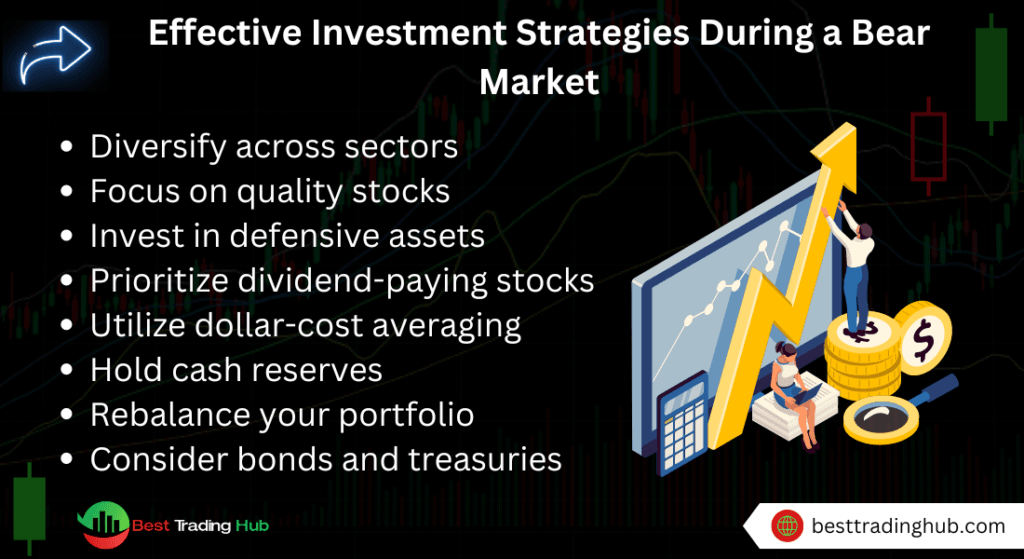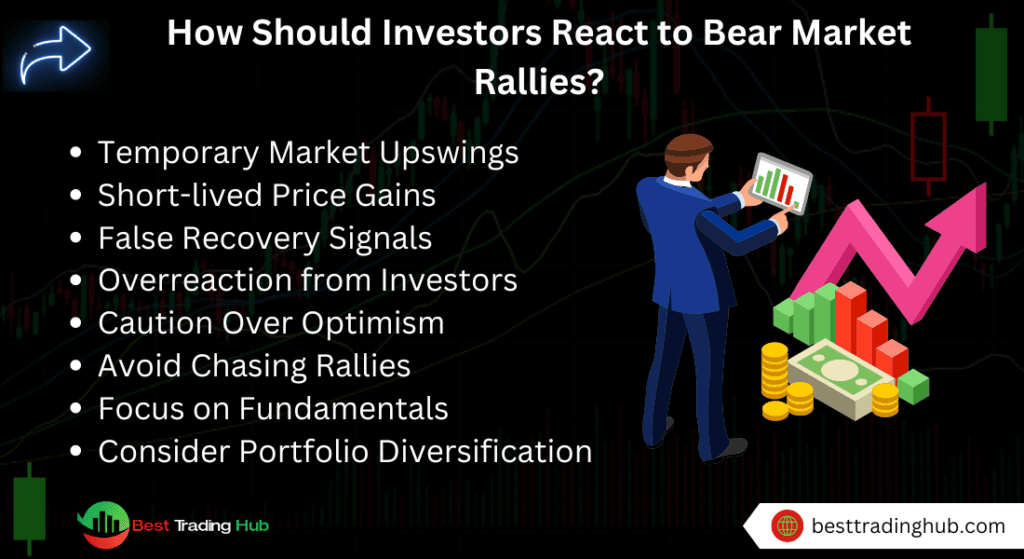Navigating the complexities of financial markets can be challenging, especially during periods of economic downturns. Understanding bear markets is crucial for investors looking to safeguard their assets and make informed decisions during these volatile times. A bear market represents more than just declining stock prices; it embodies a shift in investor sentiment and economic conditions that can have profound implications on portfolios.
In this article, we will delve into the fundamentals of bear markets, exploring their causes, characteristics, and the strategies investors can employ to navigate them successfully. By gaining a deeper understanding of bear markets, investors can better prepare for future economic shifts and potentially turn market challenges into opportunities.
Table of Contents
How Does a Bear Market Differ from a Bull Market?
A bear market and a bull market represent two distinct phases in the financial markets, driven by contrasting investor sentiments and economic conditions. A bear market is typically characterized by a prolonged decline in stock prices, usually defined by a 20% or more drop from recent highs. This phase is marked by widespread pessimism, reduced investor confidence, and a general economic slowdown. Investor sentiment in a bears market is largely negative, leading to a self-reinforcing cycle of selling, which further drives down prices.
In contrast, a bull market occurs when prices of securities rise consistently, typically by 20% or more. This phase is driven by optimism, strong economic indicators, and increased investor confidence, leading to more investments and higher valuations. During a bull market, the economy generally expands, employment rises, and consumers spend more, which in turn supports corporate earnings and stock prices. While bears markets are associated with fear and caution, bull markets are linked with growth and risk-taking.
Key Differences Between Bear and Bull Markets:
- Investor Sentiment: Negative in bears markets, positive in bull markets.
- Economic Indicators: Bears markets often coincide with economic slowdowns, while bull markets occur alongside economic growth.
- Market Trends: Bears markets involve declining prices, whereas bull markets see rising prices.
What are the Common Causes of a Bear Market?
Bear markets are often triggered by a variety of external factors that lead to a significant downturn in investor confidence and economic performance. One of the primary causes is a recession, where economic activity slows down, leading to decreased corporate earnings and a negative outlook for the future. Other factors that can trigger this market include rising interest rates, which increase the cost of borrowing and reduce consumer spending, and geopolitical events, such as wars or trade conflicts, which can create uncertainty in the markets.
Additionally, high inflation can erode purchasing power and corporate profitability, contributing to a bears market. When prices rise faster than wages, consumers may cut back on spending, which in turn affects company revenues and stock prices. Another significant factor is the bursting of economic bubbles—when asset prices are driven up by speculation and eventually crash, leading to a market downturn. These causes are often interconnected, and their cumulative effects can lead to prolonged periods of market decline.
Key Causes of Bear Markets:
- Economic Recession: A significant slowdown in economic activity.
- High Inflation: Decreases consumer spending and profitability.
- Interest Rate Hikes: Increases the cost of borrowing, slowing down investment.
- Geopolitical Events: Create uncertainty and disrupt markets.
- Bursting of Economic Bubbles: Speculative bubbles that lead to market corrections.
How Long Do Bear Markets Typically Last?
The duration of a bear market can vary significantly, depending on the underlying causes and the response of economic policies. On average, this markets last about 14 months, but this can range from a few months to several years. The shortest bears markets, like the one in 2020 triggered by the COVID-19 pandemic, lasted only a few months, while others, such as the Great Depression in the 1930s, extended for several years.

It typically follow a cycle where initial declines are followed by brief periods of recovery, known as bear market rallies. However, these rallies are often temporary, and prices may continue to decline until the market finally bottoms out. Historically, the market has always recovered from bear phases, eventually transitioning into a bull market. However, the recovery time varies; some markets bounce back quickly, while others take years to return to previous highs.
Characteristics of Bear Market Duration:
- Average Duration: Typically around 14 months.
- Short-Term Bear Markets: Can last just a few months (e.g., COVID-19).
- Long-Term Bear Markets: May extend for years (e.g., the Great Depression).
- Bear Market Rallies: Temporary recoveries that may lead to further declines.
What are the Different Types of Bear Markets?
Bear markets can be broadly categorized into cyclical and secular bear markets, each with distinct characteristics and implications. Cyclical bear markets are short-term in nature, typically lasting from a few weeks to several months. They are often triggered by temporary economic disruptions or market corrections and are generally followed by a swift recovery. These markets are usually less severe in their impact and are seen as part of the normal market cycle.
On the other hand, secular bear markets are long-term and can last for years, sometimes even over a decade. They are characterized by extended periods of poor returns across major asset classes, often accompanied by stagnation in economic growth. Secular bears markets may include several shorter bull markets or rallies within the broader downward trend, but the overall direction remains negative. These markets reflect deep-rooted economic issues that take longer to resolve, making recovery slower and more challenging.
Types of Bear Markets:
- Cyclical Bear Markets: Short-term, lasting weeks to months, often followed by quick recovery.
- Secular Bear Markets: Long-term, lasting years, with slow recovery and prolonged economic stagnation.
What are the Stages of a Bear Market?
Bear markets typically progress through four distinct stages, each marked by specific investor behaviors and market dynamics. The first stage is Distribution, where the market is still near its peak, but some investors start to sell off assets due to rising uncertainties. Although the broader market sentiment remains positive, this initial sell-off begins to push prices downward.
The second stage, Panic, is when fear and uncertainty dominate the market. As economic indicators worsen and external shocks (such as geopolitical events or financial crises) occur, more investors start selling, leading to sharp declines in asset prices. This stage is often characterized by high volatility and large trading volumes as investors try to liquidate their holdings.
In the third stage, Capitulation, even the long-term investors who initially held onto their assets begin to sell in desperation. Prices fall steeply, and the market reaches its lowest point. Finally, the Recovery stage begins, where prices stabilize as investor sentiment slowly improves, and the market starts to rise again. However, recovery is often gradual, with many investors remaining cautious.
Stages of a Bear Market:
- Distribution: Initial selling as market sentiment starts to shift.
- Panic: Sharp declines and high volatility as fear dominates.
- Capitulation: Steep price drops as long-term investors exit.
- Recovery: Gradual stabilization and rise in prices as sentiment improves.
How Do Bear Markets Impact Different Asset Classes?
Bear markets affect various asset classes differently, making it crucial for investors to understand these dynamics to manage their portfolios effectively. Stocks are typically the most affected during a bears market, with high volatility and steep declines in prices, especially for companies with high debt levels or weak business models. This volatility can result in significant losses for equity investors as confidence in the market erodes.
Bonds are often considered safer investments during bear markets, especially government bonds. These are seen as more stable and less prone to the wild price swings seen in stocks. However, not all bonds are equally safe; corporate bonds can be risky if the issuing companies face financial difficulties. Commodities like gold tend to perform well during this markets as they are seen as safe-haven assets, retaining their value when other investments falter. On the contrary, commodities like oil may suffer if global demand decreases, contributing to the overall economic downturn.
Real estate investments generally slow down during bear markets, as economic contraction leads to reduced demand for both commercial and residential properties. However, real estate can still be a viable investment if it provides ongoing income, such as rental yields, which can help cushion the impact of declining property values.
Impact on Asset Classes:
- Stocks: High volatility and steep price declines.
- Bonds: Safer, but corporate bonds can be risky.
- Commodities: Safe-haven assets like gold perform well; others may decline.
- Real Estate: Slowed demand, but rental income can provide stability.
What Investment Strategies are Effective During a Bear Market?
Investing during a bear market requires a shift in strategy to protect assets and potentially capitalize on lower prices. One of the most common strategies is defensive investing, which focuses on assets that are less likely to be affected by the economic downturn. This often includes stocks in sectors like utilities, healthcare, and consumer staples—industries that provide essential goods and services that people need regardless of economic conditions. Additionally, high-dividend stocks can offer steady income even when stock prices are falling, providing some protection against market volatility.

Another strategy is to diversify investments across different asset classes such as bonds, precious metals, and real estate. Diversification helps reduce risk, as these assets often perform differently under market stress. For example, while stocks may decline during this market, bonds and gold may hold their value or even appreciate. This strategy helps to balance the portfolio and minimize potential losses.
Effective Investment Strategies:
- Defensive Investing: Focus on essential sectors like utilities and healthcare.
- High-Dividend Stocks: Provide income and stability during downturns.
- Diversification: Spread investments across stocks, bonds, and commodities to reduce risk.
How Can Investors Identify Opportunities in a Bear Market?
While bear markets are generally viewed as challenging, they can also present unique investment opportunities for those who are prepared. One key approach is value investing, where investors look for fundamentally strong companies whose stock prices have been unfairly depressed due to the overall market decline. These stocks may be undervalued relative to their intrinsic worth, offering significant upside potential when the market recovers.
Another opportunity lies in contrarian investing, which involves buying assets that are currently out of favor with the majority of investors. This strategy is based on the belief that market trends often reverse, meaning that today’s laggards could become tomorrow’s leaders. However, this requires careful analysis and a strong understanding of market fundamentals to avoid value traps.
Opportunities During a Bear Market:
- Value Investing: Focus on undervalued, fundamentally strong companies.
- Contrarian Investing: Invest in out-of-favor assets with potential for future growth.
What is the Role of Government and Central Banks During a Bear Market?
During a bear market, government agencies and central banks play a crucial role in stabilizing the economy and restoring investor confidence. One of the primary tools at their disposal is monetary policy, where central banks, like the Federal Reserve, may lower interest rates to make borrowing cheaper. This encourages both consumer spending and business investment, which can help to revive economic growth. Additionally, central banks might implement quantitative easing (QE), where they purchase financial assets to inject liquidity into the market, further supporting economic activity.
On the fiscal side, governments may deploy expansionary fiscal policies to stimulate the economy. This can include increased public spending on infrastructure projects and services, as well as tax cuts to boost disposable income for consumers. Such measures aim to create jobs, increase demand, and support businesses during tough economic times. These combined efforts can help shorten the duration of a bears market and mitigate its impact on the economy.
Government and Central Bank Roles:
- Monetary Policy: Lowering interest rates and quantitative easing to boost liquidity.
- Fiscal Policy: Increased government spending and tax cuts to stimulate economic growth.
How Can One Differentiate Between a Market Correction and a Bear Market?
Understanding the difference between a market correction and a bear market is crucial for investors as it informs their decision-making process. A market correction is typically a short-term decline of about 10% from recent highs, often occurring during a bull market as a way to adjust overvalued assets to more sustainable levels. Corrections are relatively common and are often seen as healthy adjustments that can prevent bubbles from forming.
In contrast, a bear market represents a more prolonged and severe decline, generally defined by a drop of 20% or more from recent highs. Bears markets usually last several months to years and are often triggered by broader economic downturns or systemic issues within the financial markets. Unlike corrections, which can be quick and sharp, bears markets involve sustained negative sentiment, lower investor confidence, and significant economic challenges.
Key Differences:
- Duration: Corrections are short-term; bear markets are long-term.
- Severity: Corrections involve a 10% decline; bear markets see a 20% or more drop.
- Triggers: Corrections adjust overvalued assets; bear markets result from broader economic downturns.
What Historical Examples of Bear Markets Can We Learn From?
Studying historical bear markets provides valuable insights into how these periods of economic downturns unfold and what lessons investors can learn. One of the most notable examples is the Great Depression of 1929, which led to a prolonged bears market that lasted nearly a decade. Triggered by the stock market crash of October 1929, this bears market was exacerbated by widespread bank failures, high unemployment, and deflation. It highlighted the dangers of excessive speculation and the importance of regulatory frameworks in financial markets.

Another significant bear market occurred during the 2007-2009 financial crisis, also known as the Great Recession. This was primarily caused by the bursting of the housing bubble in the United States, which led to a global financial meltdown. The S&P 500 lost about 50% of its value during this period. The lessons from this market include the critical role of financial regulation, the risks of excessive leverage, and the importance of diversification to mitigate systemic risks.
Historical Bear Markets:
- Great Depression (1929-1939): Caused by the stock market crash, leading to widespread economic devastation.
- Financial Crisis (2007-2009): Triggered by the housing bubble burst, highlighting the need for financial regulation and diversification.
What Psychological Factors Influence Bear Markets?
The psychology of investors plays a significant role in the onset and duration of bear markets. Fear and panic are two of the most influential emotions, often leading to mass selling as investors try to cut their losses. This behavior can create a self-fulfilling prophecy, where the fear of losing more money leads to further declines in asset prices, thus prolonging this market. As fear spreads, even fundamentally strong stocks can see their prices fall.
Another psychological factor is herd mentality, where investors follow the actions of the majority, often without independent analysis. During a bears market, this can lead to widespread panic selling, exacerbating market declines. On the flip side, loss aversion—the tendency to prefer avoiding losses over acquiring equivalent gains—can cause investors to hold onto declining assets for too long, hoping for a recovery that may not come soon.
Psychological Influences in Bear Markets:
- Fear and Panic: Leads to mass selling and exacerbates market declines.
- Herd Mentality: Following the majority without analysis can intensify downturns.
- Loss Aversion: Causes investors to hold onto losing investments longer than advisable.
How Can Diversification Help Mitigate Bear Market Risks?
Diversification is one of the most effective strategies to mitigate risks during a bear market. By spreading investments across various asset classes, sectors, and geographical regions, investors can reduce the impact of a downturn in any single market segment. For instance, while equities may suffer significant losses during this market, other asset classes such as bonds, gold, and real estate might hold their value or even appreciate, providing a cushion against overall portfolio losses.
A well-diversified portfolio might include a mix of domestic and international stocks, government and corporate bonds, commodities like gold, and real estate investments. This broad exposure ensures that the poor performance of one asset class does not overly affect the entire portfolio. Moreover, diversification within asset classes, such as investing in various sectors (e.g., technology, healthcare, utilities), further spreads risk. This approach helps stabilize returns and minimizes volatility, which is particularly important during the uncertain times of this market.
Benefits of Diversification:
- Risk Reduction: Spreads risk across different asset classes and sectors.
- Stabilized Returns: Minimizes volatility and stabilizes portfolio performance.
- Broader Exposure: Ensures that losses in one area do not overly impact the entire portfolio.
What are Bear Market Rallies and How Should Investors React to Them?
A bear market rally is a temporary increase in stock prices during an overall downward trend. These rallies can be deceptive, often giving the impression that the market has turned a corner and is on the path to recovery. However, in most cases, bears market rallies are short-lived, and prices tend to fall again as the underlying economic issues have not been resolved. This can lead to further declines as investors who bought during the rally realize the market has not fully recovered.

Investors should approach bears market rallies with caution. It’s important to avoid making impulsive decisions based on short-term market movements. Instead, investors should focus on the long-term fundamentals of their investments and resist the urge to time the market. For those looking to capitalize on these rallies, it may be wise to use them as opportunities to rebalance portfolios or to gradually invest in high-quality assets that are likely to perform well when the market eventually recovers.
Dealing with Bear Market Rallies:
- Caution: Avoid impulsive decisions based on temporary market increases.
- Long-Term Focus: Maintain a focus on long-term fundamentals rather than trying to time the market.
- Portfolio Rebalancing: Use rallies as opportunities to rebalance and invest in high-quality assets.
How Can Investors Prepare for Future Bear Markets?
Preparation is key to weathering future bears markets successfully. One of the first steps is to build a cash reserve or emergency fund that can cover several months of living expenses. This ensures that investors are not forced to sell their investments at a loss to meet financial obligations during a market downturn. Additionally, maintaining a well-diversified portfolio that includes safer asset classes like bonds and gold can help mitigate losses during a market bear.
Another critical preparation strategy is to review and adjust asset allocation regularly. As investors approach retirement or other financial goals, they may want to shift their portfolios to more conservative allocations to protect against significant losses. It’s also essential to have a long-term investment plan that aligns with personal financial goals and risk tolerance, which can help investors stay the course during periods of volatility.
Preparing for Bear Markets:
- Build a Cash Reserve: Ensure sufficient liquidity to avoid selling investments at a loss.
- Diversify Portfolio: Include safer asset classes like bonds and gold.
- Review Asset Allocation: Adjust to more conservative allocations as needed.
Conclusion
In conclusion, understanding bear markets is crucial for investors who wish to navigate economic downturns with resilience. By recognizing the stages, causes, and effective strategies during this market, investors can mitigate risks and even identify potential opportunities. Diversification, defensive investing, and staying informed are key to weathering the challenges of this market.
It’s also important to contrast this with understanding bull markets, where optimism drives stock prices higher. Just as bear markets teach caution and defensive strategies, bull markets emphasize growth and capitalizing on upward trends. Both market conditions are integral to a well-rounded investment strategy, and understanding how to respond to each can significantly enhance long-term financial success. This interconnected knowledge ensures investors are prepared, no matter which way the market turns.





